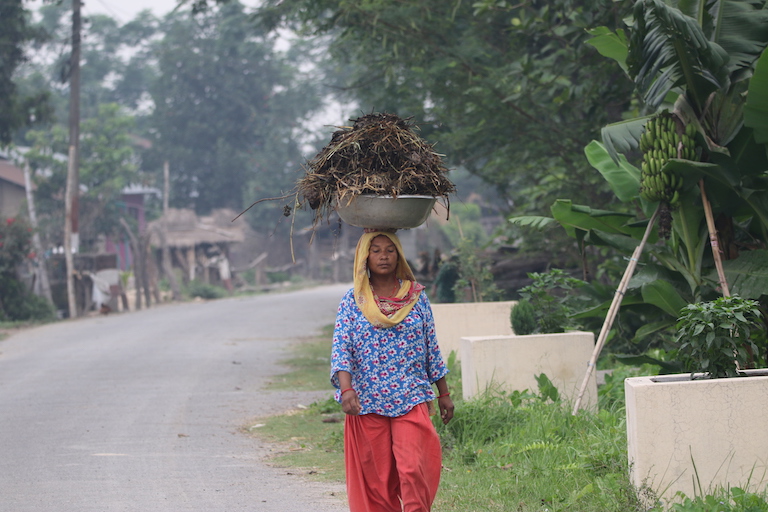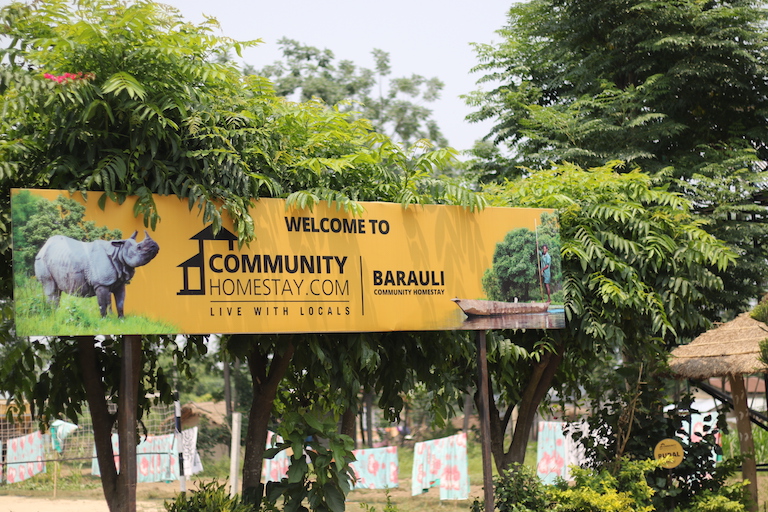- When faced with criticism that local people don’t benefit from wildlife tourism to Nepal’s Chitwan National Park, officials and conservationists point to homestay programs set up in communities on the park’s borders.
- These homestay programs aim to provide the communities with alternative livelihoods and to create an incentive to protect forests and wildlife.
- In the villages of Amaltari and Barauli, two very different homestay programs have been established, catering to different groups of visitors. Both models have their strengths, but also their shortcomings.
NAWALPUR DISTRICT, Nepal — A few kilometers from the town of Danda along the East-West Highway in Nepal’s southern plains, the road diverges. One fork leads to Barauli, the other to Amaltari — both home to a predominantly Tharu ethnic population on the western edge of Chitwan National Park, famous for its greater one-horned rhinos.
“Which way do you want to go?” asks the auto-rickshaw driver. “Most Nepalis who come here want me to take them to Amaltari, foreigners ask for Barauli,” he says. Both Amaltari and Barauli host home stays, a bed-and-breakfast program for tourists seeking a local experience by living with the community. Both were setup in the buffer zone of the park after the government introduced its Home Stay Working Procedure in 2010, which sets standards for urban and rural households to run homestays. But the similarities end there.

On a summer evening in Amaltari, awarded the best homestay program in 2017 by the ministry of tourism, big yellow buses with “English School” emblazoned on them honk their way through the narrow road, dropping children home. While men sit in the shade of trees, relaxing after a day’s work in the field, women are busy chopping vegetables for dinner. On both sides of the road, visitors can see who owns each homestay unit. “This is homestay #19, I am its owner.That is what the sign here says,” says Shanker Prasad Chaudhary. All of the units bear names of local men.
There are also clusters of houses far from the road where no such signs are visible. These belong to members of the Musahar ethnic group, and are not part of the homestay program.
The Amaltari homestay program, established in 2013 by local entrepreneurs with help from the government and WWF, is the go-to example for conservationists, who are often asked about the benefits local people receive from tourism. Officials point to Amaltari when critics say tourism revenue ends up with big hotels rather than with indigenous communities, or that people living near the park shoulder all the burdens of conservation with none of the gains.
The homestay program here is one of 16 run by local communities and supported by WWF Nepal in the Terai Arc Landscape, the hugely biodiverse lowlands along the Nepal-India border. They were established with the threefold aim of safeguarding the environment and wildlife, providing economic benefits, and ensuring social justice.
Significant changes in all three of these areas are already visible, say local residents who operate the 48- room program at Amaltari. “A lot has changed in the area since the homestay came into operation,” says Dhani Ram Gurahu, who manages the project. “Before the homestay, we had problems managing the community forest as the people did not have incentives to look after the forest.”Villagers have now realized that if they look after the forest, wild animals such as the one-horned rhinos (Rhinoceros unicornis) will start roaming the area, and tourists will come in search of them, he says. This, in turn, has helped conserve the community forest. Villagers are also earning from ancillary services and enterprises such as tours by jeep and elephant.

Shanker Prasad, a carpenter by training, says the money the program has brought to the village has proven to be a lifeline for the community. He quit his job to focus on the homestay and run a restaurant in the village. “We have guests throughout the year, even when we have heavy rainfall,” he says. According to the homestay office, the money raised from the program is divided equally among the members every month, and homestay units receive guests on a rotating basis to ensure no one misses out.
Jog Maya Mahato, who also runs a homestay, has seen a more important change in her village. She says that before the program began, the village didn’t have access to roads. “We had to cycle for a kilometer [to reach the nearest road] even when we had to rush someone to the hospital,” she says.
But the changes seen in the lives of women in Amaltari have been beyond her imagination, she says. “In the past, women, most of whom don’t know how to read and write, were limited to their household chores. They were reluctant to talk to anyone outside their family,” she says. “But these days, they have the confidence to talk to outsiders, even foreign tourists. They can even ask some basic questions in English.”

In addition, the village has seen a revival of interest in Tharu culture among the youth. “In the past, we did not know how to perform the Tharu dance as we did not find it worth learning,” says Jog Maya. “But after we decided to run the homestay, we invited elders from neighboring villages to teach us.” Similarly, residents are more aware of the importance of practicing good hygiene and sanitation, as they don’t want to turn off guests with dirt and filth, says manager Gurahu.
But it’s not all smooth sailing for the homestay program. There are challenges galore, says rural development scholar Suresh Acharya in a recent paper on Amaltari. The official policy of the Homestay Village Committee is to include households of all ethnic groups, but Acharya says marginalized groups such the Bote and Musahar are generally too poor to invest in homestays and thus haven’t directly benefited from the program.
“[The] majority of homestay operators in Amaltari are Tharus with only three Bote households and no Musahars. This fact portrays an unbalanced distribution of homestay benefits which limits the future growth of homestays. With the increasing income, the infrastructures are also growing. However, little has been developed around the Musahar settlements,” he writes.
“Yes, not all poor households participate in homestay programs,” says Keshav Badal, president of the Nepal Homestay Association. He says that while communities like the Bote and Musahar may not receive direct benefits, they still earn by participating in cultural programs and selling handicrafts and agricultural produce to the homestay owners.
There can also be social complications. Elderly members of the Tharu and Bote communities often have difficulty understanding languages other than their native tongues, and this increases the possibility of misunderstanding between guests and hosts.
Increased incomes, and the promise of opportunities in the tourism sector, is also leading to cultural changes. Parents aspire to send their children to English-medium schools, and those children spend their time listening to English songs on their mobile phones. “Westernization of culture can hamper the homestay in the long run,” says Acharya, noting that it can erode the traditional ways of life that attract tourists in the first place. Local tradition and culture can become limited to dances and handicrafts meant to be shown to tourists.
Acharya also found that village gatherings happen less often as people are busy with guests: “Although, the homestay households claim …social solidarity, everyday interactions among the villagers have [been] significantly reduced. The economic life is better with homestay income but at the cost of social life, particularly the time they could have offered to their relatives and their own children.”
Similarly, he observed that as villagers spend more time serving visitors, agricultural output has declined. This has increased their dependency on the homestay program.
There’s also been a failure to market the homestay program to foreign tourists, who locals say tend to stay longer and spend more money than domestic visitors. Most of the tourists who come to Amaltari are Nepalis.

Meanwhile, on a summer evening in Barauli, located around a 15-minute drive from Amaltari, community members welcome a group of British tourists to their homestay. After the welcome ceremony is over, guests are assigned one of the neatly aligned mud houses with thatched roofs, built specifically to host tourists. The names on the huts read “Tara,”“Janaki,”“Tika” —names of women in this community of 12 households.
“We welcome the guests with traditional garlands and flowers,” says Tara Devi Mahato, a resident of Barauli. Mahato and her friends started the homestay program in 2015 with help from a social enterprise company called the Community Homestay Network or communityhomestay.com. “Most of our guests are foreigners. It’s easier to deal with foreigners as they do not make noise after drinking and they adhere to our timetables,” Mahato says.
Representatives from the Community Homestay Network, which is affiliated with Kathmandu-based Royal Mountain Travel, initiated the agreement, approaching the community with the idea of starting a homestay program. The plan was for local people to manage the service, while the company marketed it to tourists worldwide. But within a few months of coming into operation, the locals said they simply didn’t have the skills to manage the facility. “That is why we asked community homestay.com to manage the facility for us,” says Mahato, who now works for the company. “Under the deal, they shall manage the area for 10 years,” she says. “We don’t know if we’ll be able to run it after 10 years.”
Janak Chaudhary, operations manager of Barauli Community Homestay and an employee of the Community Homestay Network, says the program differs from that in Amaltari as it focuses on foreign guests and the empowerment of local women. “Foreign tourists come in groups and they want to stay and eat together. That is not possible in traditional homestays where the units are located far from one another. That is why we have built a community dining area and built traditional homes close to one another,” he says.
Chaudhary says the project is still a homestay, not merely a hotel: “First, the units are owned by local women. They receive 5,500 rupees [$50] as rent directly to their bank account every month—we do this as we know that women manage money better than men do. Second, we employ local women who had to go out of the village to find work. Third, we try to source our food from the local agriculture produce.”

But that’s not enough, says a homestay owner in Amaltari. “What about the sustainability of the project? What about training locals in hospitality and making them their own bosses?” he asks.
A Barauli homestay owner, meanwhile, asks of his counterparts in Amaltari: “What about marketing a homestay? What about providing quality services? What about women’s empowerment?”
Back in Danda, life goes on for the auto-rickshaw driver. A couple seeks a ride to the nearest homestay. “Do you want to take the road to Amaltari or Barauli?”
FEEDBACK: Use this form to send a message to the author of this post. If you want to post a public comment, you can do that at the bottom of the page.